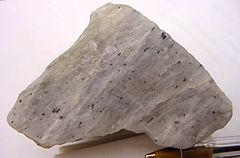Nephelite
| Nepheline | |
|---|---|
 |
|
| General | |
| Category | Tectosilicate, feldspathoid |
|
Formula (repeating unit) |
(Na,K)AlSiO4 |
| Strunz classification | 9.FA.05 |
| Crystal system | Hexagonal |
| Crystal class | Pyramidal (6) H-M Symbol: (6) |
| Space group | P63 |
| Identification | |
| Formula mass | 146.08 g/mol |
| Color | White, Gray, Brown, Brownish gray, Reddish white |
| Crystal habit | Massive granular to prismatic |
| Twinning | On [1010], [3365], and [1122] |
| Cleavage | [1010] Poor |
| Fracture | Subconchoidal |
| Mohs scale hardness | 6 |
| Luster | Vitreous - greasy |
| Streak | White |
| Specific gravity | 2.55 - 2.65, average = 2.59 |
| Optical properties | Uniaxial (-) |
| Refractive index | nω = 1.529 - 1.546 nε = 1.526 - 1.542 |
| Birefringence | δ = 0.003 - 0.004 |
| Other characteristics | non-radioactive, non-magnetic, non-fluorescent |
| References | |
Nepheline, also called nephelite (from Greek: νεφέλη, "cloud"), is a feldspathoid: a silica-undersaturated aluminosilicate, Na3KAl4Si4O16, that occurs in intrusive and volcanic rocks with low silica, and in their associated pegmatites.
Nepheline crystals are rare and belong to the hexagonal system, usually having the form of a short, six-sided prism terminated by the basal plane. The unsymmetrical etched figures produced artificially on the prism faces indicate, however, that the crystals are hemimorphic and tetartohedral, the only element of symmetry being a polar hexad axis. It is found in compact, granular aggregates, and can be white, yellow, gray, green, or even reddish (in the eleolite variety). The hardness is 5.5 - 6, and the specific gravity 2.56 - 2.66. It is often translucent with a greasy luster.
The low index of refraction and the feeble double refraction in nepheline are nearly the same as in quartz; but since in nepheline the sign of the double refraction is negative, while in quartz it is positive, the two minerals are readily distinguished under the microscope. An important determinative character of nepheline is the ease with which it is decomposed by hydrochloric acid, with separation of gelatinous silica (which may be readily stained by coloring matters) and cubes of salt. For this reason, a clear crystal of nepheline becomes cloudy when immersed in acid.
Although sodium and potassium are always present in naturally occurring nepheline in approximately the atomic ratio (3:1), artificially prepared crystals have the composition NaAlSiO4; the corresponding potassium compound, KAISiO4, which is the mineral kaliophilite, has also been prepared artificially. It has therefore been suggested that the orthosilicate formula, (Na,K)AlSiO4, represents the true composition of nepheline.
...
Wikipedia
